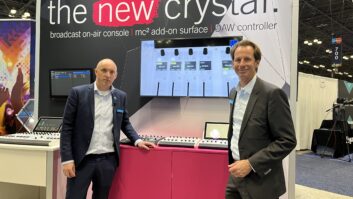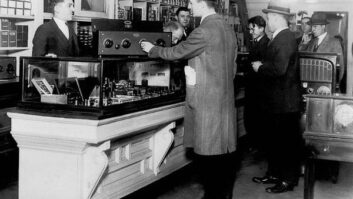Mobile Wireless Broadband: A Trend for Radio Reporting?
The days of scratchy cell phones and spotty RPU signals may be drawing to a close with the advent of wireless technology that makes filing over the Internet from remote places faster, easier and more economical. The newsroom of the future might have a steering wheel and fenders instead of desks and chairs. And at least one news manager predicts IP-based technology will be more heavily used to cover upcoming big events, such as the next election cycle.
Just after Hurricane Katrina, I was outfitted with a Verizon PC 5740 EvDO (for “Evolution Data Only”) wireless broadband access card.
“Virtually all of our correspondents have the capability of using them,” said Jeff Fitzgerald, director of news operations for ABC News Radio in New York. “Every time they go into the field, they have them.”
Since my card was activated last August, a day hasn’t passed that I haven’t used it to its fullest, not just for checking e-mail and researching stories on location, but for filing material to ABC and to my home station, WBAP(AM) in the Dallas-Ft. Worth market.
I’ve found that the speed of sending audio files via the broadband card is comparable to using my Blitzz Super G Wireless Notebook Adapter. The big difference is that the Verizon product doesn’t require me to sit in a Wi-Fi “hot spot” for service.
Although I still carry my Blitzz card, questions linger about the legality of “borrowing” bandwidth from unsuspecting hosts. A Florida man caught sitting in his vehicle with a laptop computer and accused of tapping into his neighbor’s open wireless router was charged last year by St. Petersburg police with “unauthorized access to a computer network,” a third-degree felony that carries a maximum sentence of five years in prison.
For my filing process, interviews/voice tracks are recorded onto my Marantz PMD660 Flash recorder, and then fed into Cool Edit, my old tried-and-true version of the software now known as Adobe Audition. My Dell Latitude LS is secured to a RAM laptop mount, purchased for $175 online, and installed between the front seats of my station’s Chevy Blazer news unit.
Quick production, filing
I edit stories and convert them from .wav to .mp3 format for quicker filing, then e-mail the material to WBAP or upload it to ABC’s FTP site.
Once the user is comfortable with the process, it takes only a few minutes from finishing an interview to having the produced story arrive at the other end.
Readers will find a few drawbacks to filing wirelessly, especially if they’re working primarily out of a vehicle and using the Marantz deck that I use. In order to “Flash” audio from the PMD660 via the unit’s USB port, the deck must be plugged into AC. I get around the problem with a power inverter, purchased for about $30 at a sporting goods store. In the photo that accompanies this story, the inverter can be seen mounted atop the police/fire/aviation scanner located near the bottom of the shot.
The Chevy Blazer is ideal as a mobile newsroom because it has two power ports, besides the cigarette lighter. I’ve hard-wired the scanner into the lighter, freeing up one port for a cell-phone charger and the other for the power inverter.
Powering the PMD660 is worth the trouble because of the time you’ll save in moving digital audio tracks into your editing software. Of course, the other solution is to play the analog cuts into your laptop, real-time. The Marantz, with its dual line/headphone outputs, is great for this; you can hear the cuts being fed into the mini jack of the computer, assuming you use the mini “line” output jack.
If you’ve ever tried to balance your computer on your knee, you’ll know what a great investment the RAM laptop mount is. You should not use your keyboard while driving down the street, but once a map, for example, is on your screen, it takes only a glance away from the road to see where you’re going.
Speed, baby, speed
Normally I keep the laptop closed while I’m driving, but when it’s open, it blocks only a sliver of my peripheral driving vision. Once I’m parked, I can swing the computer into position and begin working with my audio.
The heart of the mobile newsroom is the wireless access card. My PC5740, about the size of a Chiclets box, boasts download speeds of 400-700 kilobits per second, many times faster than a dial-up connection, but much slower than the 108 Mbps maximum of the Super G Wi-Fi connection. The Verizon card can be had for about $50 after rebates, and provides unlimited Internet access for around $80 per month.
“The benefits are worth the investment,” said ABC’s Fitzgerald, who notes that ordering a single POTS line can cost $400. “You can file anywhere you are, whether you’re on a campaign bus or out in the field without access to phone lines.”
Sprint Nextel has rolled out its own EvDO product, AirCard 580 by Sierra Wireless, which lists on the Sprint Web site for free, after rebate, and PCS Unlimited Data Link for $80 per month. Download speeds for the Sprint Nextel and Verizon products appear to be identical, but coverage maps on both companies’ sites show different availability, depending upon where you live.
On the issue of signal strength, the Verizon card has been extremely reliable. (I have not used the AirCard). Driving from Dallas to Houston, for example, I found that I was still online well outside of either major city. My Internet access did eventually drop off, but not until I was nearly 100 miles south of Dallas, and then only until I came to the next town of moderate size.
The obvious drawback to FTP and e-mail filing is that it cannot be live. Or can it? Fitzgerald predicts that the next election cycle will be covered real-time via Internet Protocol using laptops, WiFi and wireless broadband cards.
“Some radio stations are broadcasting live through the Verizon card and it’s our hope to use this technology in the 2008 presidential campaigns,” Fitzgerald said. “We’ve made it known to companies providing codecs that they need to develop IP-based technology; we expect the industry to blossom.”
As more businesses and even some local governments launch wider Wi-Fi “hot spots,” the need for wireless broadband networks like that of Verizon and Sprint Nextel might eventually decline. For now, though, popping in the EvDO and going online from just about anywhere is the radio road reporter’s dream come true.
Share your wireless experiences. E-mail [email protected].












